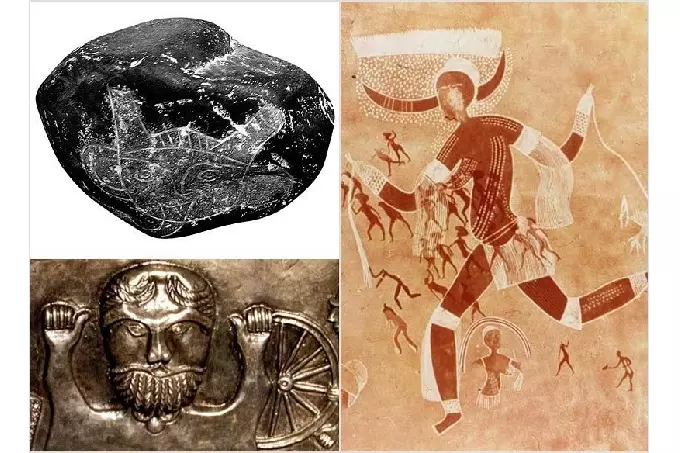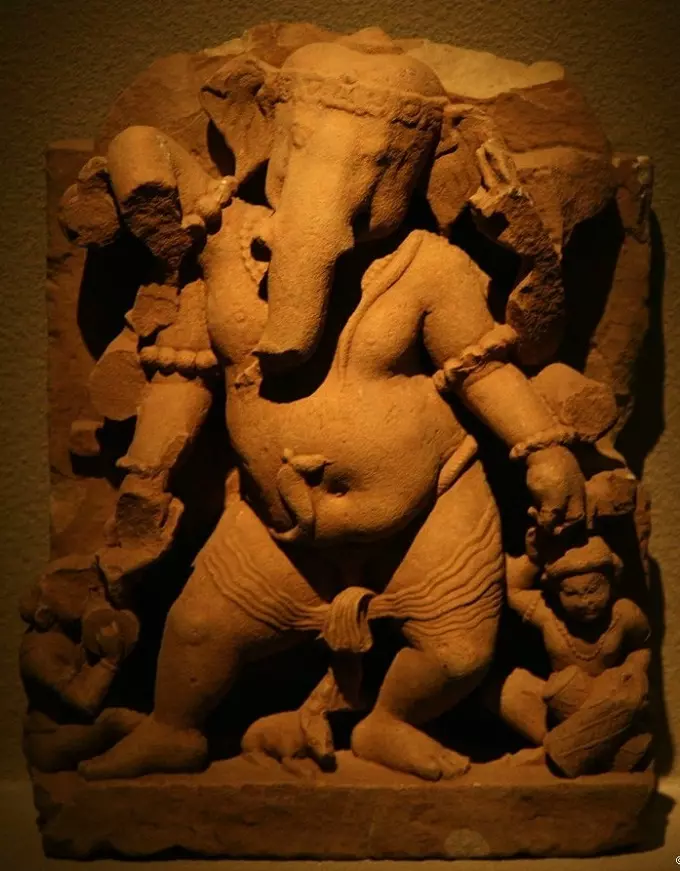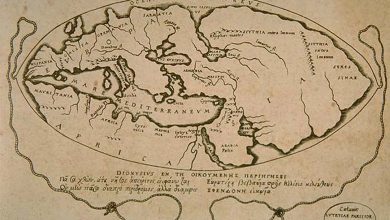Are beastmen the ancestors of man?

Ancient rock carvings of strange creatures – hybrids of humans and animals – are considered by many scientists to be “portraits” of shamans and sorcerers dressed in ritual equipment. However, archaeological finds, along with well-known cases of the birth of people with characteristic physical abnormalities, allow us to doubt the indisputability of such an interpretation.
A huge number of drawings with images of beastmen made more than 10 thousand years ago have been discovered in Europe, South Africa, and Australia. The heads of most of these creatures are decorated with horns of various sizes and shapes.
A well-known expert on prehistoric art, an employee of the Australian Museum in Sydney, Dr. Paul Taken, in an article published at the end of November 2001 in the authoritative scientific journal New Scientist (“Modern Scientist”), suggested that the drawings mentioned are not people but “therianthropes – hybrids of humans and animals that open to us a picture of the beginning of the formation of modern humanity.”
Together with another specialist in primitive art, Christopher Chippendale from the Museum of Archaeology and Anthropology at the University of Cambridge, they conducted the first truly scientific study of ancient drawings with images of therianthropes.
In Europe, including in the famous French Trois Freres (Cave of the Three Brothers), as well as in South Africa and Northern Australia, they have studied more than five thousand rock paintings. At the same time, their ancient origin was confirmed by the most modern dating methods.
Who posed for the ancient masters?
Scientists have long come to the conclusion that primitive people painted on the walls of caves what they saw in life: bison, horses, mammoths, and, of course, their brethren. But then why did these people draw so many therianthropes, most of whom are also horned? Along with the scientists mentioned above, Polish researcher of historical riddles Tadeusz Oshubsky is also studying this problem.
Here is the general opinion of these experts: until now, it was believed that the strange characters of cave art were not therianthropes at all but the same primitive people who only “worked” as shamans and were depicted in their “overalls”. And as for the horns, they say that from time immemorial, they have served as a symbol of belonging to other worlds: in different epochs and among different peoples, horns were either attribute of solar and lunar fertility deities (and general signs of holiness and beauty), or were identified with evil spirits, aggressiveness, death.
Many thousands of years ago, horns were a common accessory of various kinds of “wild people” and forest deities. These creatures did not personify evil – they simply were not like the people of “Cro-Magnon appearance” prevailing at that time. In later times, horned characters were such as the ancient Egyptian god of wisdom and the Moon Jehuti (Thoth), and the Sun god and “king of all gods Amon”. The Gauls, Germans, and Goths decorated their helmets with horns. Such an ornament symbolized strength, courage, and intrepidity.
However, the study of ancient legends and historical documents, as well as a number of details discovered by Takenom, Chippendale, and other researchers, allow us to challenge this point of view and suggest that therianthropes-hybrids – really existed as ancestors of modern man.
In the ruins of the city of Ur, founded by the Sumerians on the territory of modern Iraq about 7000 years ago, archaeologists have unearthed royal tombs, on the walls of which horned and tailed humanoid creatures are depicted. Similar creatures are also displayed on Chinese ceramic products made around 500 BC.

English researchers John and Caitlin Matthews, in the book “Mythology of the British Isles”, describe sculptural images of the Celtic deity Cernunnos, which means “horned”, in the form of a mustachioed man with deer horns on his head.
Prominent representatives of ancient culture and science – the poet Ovid, historians Pliny the Elder, and Herodotus – mentioned in their writings a tribe of fauns (people covered with wool, with goat beards, horns, and hooves) who lived in the remote forest wilds. The Roman consul and writer Philostratus, who lived at the beginning of our era, in one of the books told about the capture and taming of a wild faun in Ethiopia.
And the ancient Greek historian Plutarch describes in detail how the same faun was lured into a trap on the Black Sea coast near the Greek city of Apollonia, on the territory of modern Bulgaria. The strange creature was taken to Rome, where it was repeatedly shown to the Roman nobility during festivals and feasts. Plutarch also writes that, according to legend, the faun, the grandson of Jupiter, was the third ruler of Italy.
Horned men and giants
There is information about horned people from closer times. It is documented that in the XVII century in the English county of Leicestershire Mary Davis lived with two “ram” horns on her head, and the French historian Collin de Plancy in the early XIX century wrote about a horned monk from the monastery of Saint-Justine.
And here are two more facts. In the 80s of the XIX century in the USA, on the territory of Tioga Point in Bradford County, Pennsylvania, an expedition led by historian, Dr. J.P. Donahue, as well as professors: A.B. Skinner from the American Research Museum and V.K. Morehead from Phillips Academy excavated an earthen hill. Inside there was a burial of the remains of 68 people, dating back to 1200. Judging by the skeletons, the buried were real giants, their average height was more than two meters. But most of all, the researchers were struck by the skulls: some of them had bone outgrowths on the sides, that is, horns.
And in 1903, at one of the mines near the American city of Isola, Kansas, before dawn, a horned, long-haired humanoid creature with burning red eyes suddenly appeared, causing panic among the night shift workers. This case is described in the book “More than …” by journalist and writer Richard Lazarus.
Thus, the real existence of horned people can be considered indisputable, and as for the presence of hooves and tails, this question remains open “due to insufficient physical evidence.”
Warriors in Bear skins
In search of an answer to the question posed in the title of this article, it is appropriate to pay attention to the following information.
At the turn of the X-XI centuries, the Rostov Prince (later the Grand Duke of Kyiv) Yaroslav the Wise, traveling around his possessions, came across a settlement of unknown pagans who were in animal form. The filthy ones attacked the princely squad with a pack of terrible fighting dogs led by a huge bear. But the prince’s squad overcame this animal pack. The victory was recognized as so honorable that in its commemoration in 1010, a city was founded, named after the prince – Yaroslavl.
In Europe, warlike male animals appeared at the beginning of our era. They went into battle naked, only throwing a wolf or bear skin over their shoulders. For this, they were nicknamed berserkers (“berserker” means “bearskin”). The belligerents resorted to the help of berserkers quite often. The historian of the VIII century, Paul the Deacon, reports that the German Lombard tribe, when faced with superior enemy forces, spread a rumor that “dogheads” were rushing to their aid. Having heard about this, the enemy often retreated without taking the fight.
Patron Spirits
The first Europeans who settled in America were surprised by the strange customs of the locals. Young men who reached adulthood went in search of a personal patron spirit. Once in a fairly deserted area, young Indians began to subject themselves to cruel and very sophisticated tortures. So, one English missionary was an eyewitness to how a young man pierced through his own side, made a belt of rawhide buffalo hide through the wound, and hung himself on it from a nearby tree.
In this position, the young man remained until the image of the patron spirit appeared before his eyes. Usually, it was some strong and fearless beast. From that moment on, a mystical connection was established between the young man and the spirit, lasting until the hour of death.
The Jackal Tribe
And in Africa, every tribe living in the Congolese or Guinean jungles has had its patron since time immemorial, most often appearing in the image of a predatory animal-the progenitor. Ordinary mortals communicate with his spirit during ritual dances, which are led by a sorcerer dressed in the skin of this beast.
American Harry Wright, who was a guest at the Jackal Tribe, wrote: “That was the most unpleasant part of the ritual. In the dance, they growled, threw themselves at each other, then got down on all fours and began to sniff each other. Suddenly, something dark flew into their circle. At first, I thought it was one of the dancers, but then I saw that it was a real jackal. He ran among the dancers, growled, and rushed at them. It all ended in a wild orgy.”
In order for the protection of a jackal or, say, a leopard to extend to every man of the tribe, he had to undergo a rite of initiation. He was conducted by a sorcerer dressed in the skin of this beast. During the ceremony, young men were necessarily subjected to a test of endurance to physical pain – they, for example, could have their foreskin or front teeth removed.
The sorcerer and several of his assistants formed secret alliances. Knowing perfectly well which of the tribesmen was not able to resist them, these people in animal skins broke into homes at night, abducted children, and sold them into slavery. And bloody reprisals were often arranged over the disobedient. For example, the “leopard men from Dahomey” tore the bodies of their victims with hooks that left terrible wounds, like from the claws of a leopard.




